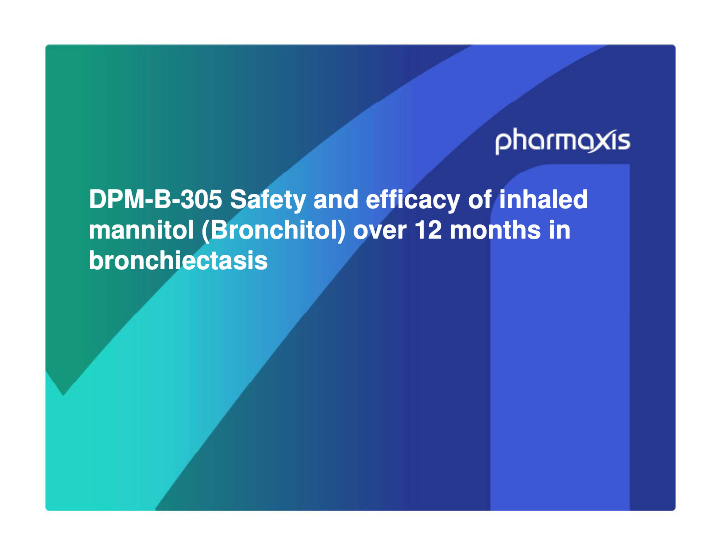



DPM DPM- -B B- -305 Safety and efficacy of inhaled 305 Safety and efficacy of inhaled mannitol (Bronchitol) over 12 months in mannitol (Bronchitol) over 12 months in ( ( ) ) bronchiectasis bronchiectasis
B- -305: Study details 305: Study details Multi ‐ center, randomized (1:1), parallel, double blind, controlled, 12 month safety and efficacy study Inclusion Criteria Confirmed diagnosis of (non ‐ CF) Bronchiectasis 18 ‐ 85 years of age FEV 1 40 ‐ 85% predicted & ≥ 1L Sputum producers (screening ≥ 10g) ≥ 2 exacerbations in past year, and ≥ 4 in the past 2 years SGRQ SGRQ total score ≥ 30 l 30 Standard therapy continued Hypertonic saline not allowed Stable condition on entry (including no major haemoptysis) Stable condition on entry (including no major haemoptysis) Pass Mannitol Tolerance Test (MTT) without pre ‐ bronchodilator use 84% of patients passed the MTT
B- -305: Study design 305: Study design Mannitol Start Tolerance study Test Test drug drug (MTT) Screening Week 0 Week 6 Week 16 Week 28 Week 40 Week 52 Week 56 Double blind phase Washout Screening and 52 weeks 4 weeks MTT 2-5 weeks Bronchitol (400mg mannitol - 10 capsules) b.i.d. before start study drug Control (50mg mannitol - 10 capsules) b.i.d. Protocol Version 5, 28 July 2010
B- -305: Endpoints 305: Endpoints Primary endpoint Exacerbation rate (graded pulmonary exacerbation) b ( d d l b ) Secondary efficacy endpoints included: St George Respiratory Questionnaire (SGRQ) score g p y Q ( Q) Days of antibiotics use Time to first exacerbation and duration of exacerbations 24 hour sputum volume 24 hour sputum volume Daytime sleepiness score ‐ Epworth (ESS) Spirometry (pre ‐ bronchodilator) Hospitalisations due to exacerbations Safety
B- -305: Demographics 305: Demographics Variable at Baseline (ITT population) n=461 M Mean age years 59 8 59.8 Gender (Female) 289 ( 62.7%) Age at diagnosis Age at diagnosis 43 5 43.5 FEV 1 mean Litres 1.72 % predicted 62.3% Bronchitol : 18.0% Study withdrawal rate Control: 17.1%
B- -305: Study results 305: Study results Primary Difference in the rates of graded pulmonary Reduced 8% Not significant endpoint d i exacerbations (rate ratio) b i ( i ) Secondary Time to first exacerbation (Hazard ratio) Improved 28% 0.78 (p=0.022) • endpoints endpoints Days of antibiotic use – duration (rate ratio) Days of antibiotic use duration (rate ratio) Improved 24% Improved 24% 0 76 (p=0 0496) 0.76 (p=0.0496) • • Quality of life: Change in SGRQ Improved 28% ‐ 2.4, (p=0.046) • Sputum weight: 24 hour collection (g) Improved 29% +2.8 (p=0.036) • Spirometric lung function Not achieved Not significant • Epworth Sleep Score Not achieved Not significant • Hospitalisations for exacerbations rate Improved 39% Not significant • ratio) Safety Safety Similar overall rates of AE’s and SAE’s between treatment groups Similar overall rates of AE s and SAE s between treatment groups • Acceptable safety profile •
st exacerbation Increased time to 1 st Increased time to 1 exacerbation Hazard Ratio Hazard Ratio 0.78 p=0.022 [95%CI: 0.63, 0.96] Median: 5.4 vs 4.1 months
Recommend
More recommend